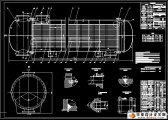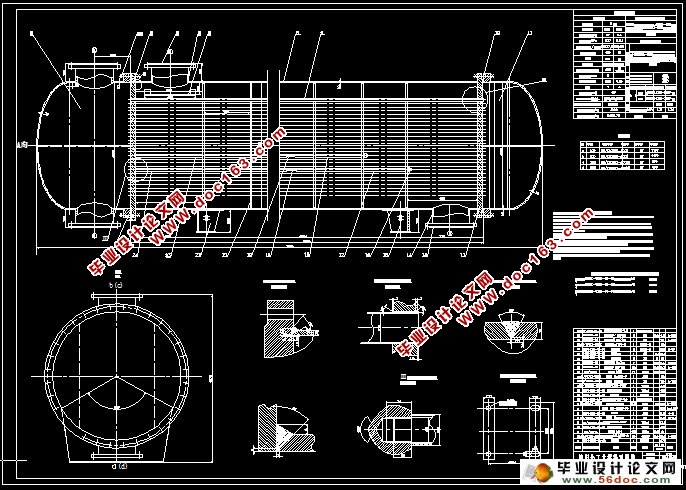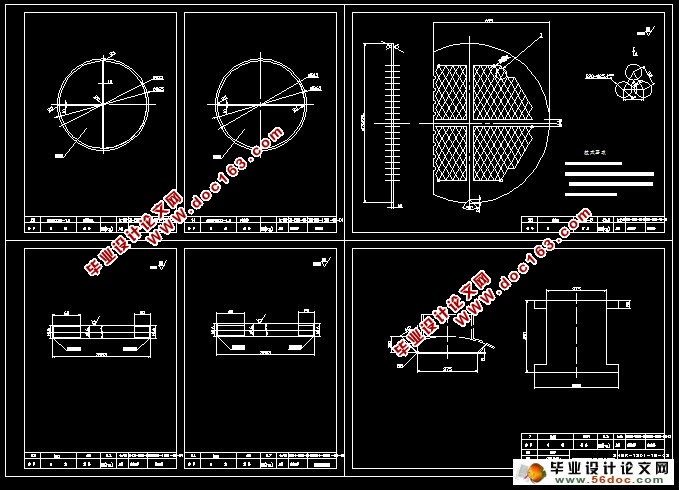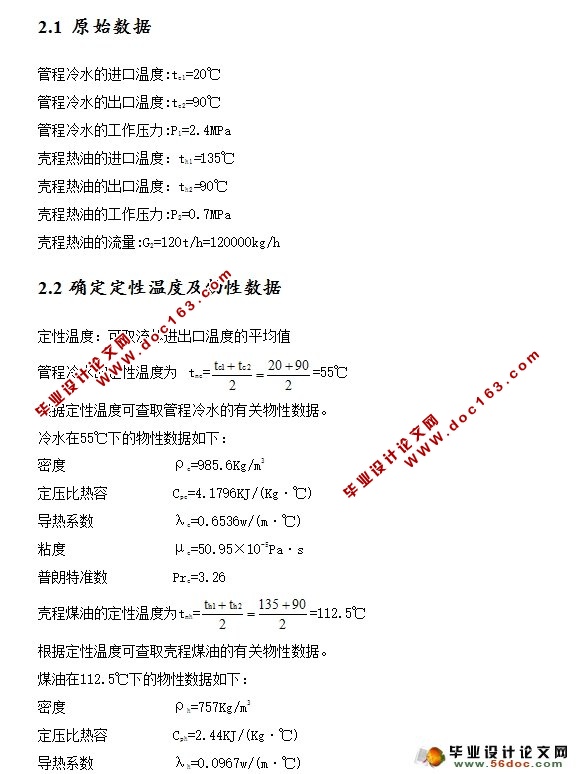流量为120t/h四管程固定管板式换热器(含CAD零件装配图)

流量为120t/h四管程固定管板式换热器(含CAD零件装配图)(设计说明书11800字,CAD图纸11张)
摘要
本设计是四管程固定管板式换热器,是目前应用最为广泛的换热器。本台换热器主要完成的是水蒸气-水之间的热量交换,设计压力为管程2.4MPa,壳程0.7MPa,管程冷水的定性温度为55℃,壳程煤油的定性温度为112.5℃。传热面积为 137 ,采用 Φ25×2.5×6000 的无缝钢管换热,则可计算出 290 根换热管。
本台换热器的管板延长兼做法兰,管板与换热管的连接方式为焊接,因管板上的应力较多,且内外温度有一定的差值,因此,对管板强度的校核是一个重点,也是一个难点,本文按照弹性支撑假设对管板进行设计和校核的。
本设计为固定管板式换热器,由管箱、壳体、管板、管子等零部件组成。其结构较紧凑,排管较多,在相同直径情况下面积较大制造较简单。固定管板式换热器的管程有双管程和四管程等几种,本设计采用单壳程,四管程。固定管板式换热器的设计包括:管子的规格和排列方式、圆筒、封头、管板的材料选择及厚度设计,折流板、防冲板的选择等。首先管子的选择是以清洗方便及合理使用管材为原则。管子在管板上的排列方式为三角形排列。因为正三角形排列时,管板的强度高、流体短路的机会少,且相同壳程内可排列更多的管子。壳体厚度计算式是由圆筒薄膜应力准则推导出的。其最小壁厚应根据标准选取。而封头采用了限制最小壁厚方法,其有效厚度应不小于封头内径的0.15%。管板是管壳式换热器中最重要的部件之一,在选材时除力学性能外,还应考虑流体的腐蚀性的影响。在计算厚度时,要在满足强度要求的前提下,尽量减少管板的厚度。折流板最常用的为圆缺型挡板,切去的弓形高度一般取外壳内径的20%-25%。 [资料来源:www.doc163.com]
固定管板式换热器的优点是:结构简单、紧凑,能承受较高的压力,造价低,管程清洗方便,管子损坏时易于堵管或更换;这种换热器使用于壳侧介质清洁且不宜结垢,并能进行清洗管束,壳程两侧温差不大或者温差较大但壳侧压力不高的场合。
关键词:换热管; 固定管板; 温差应力
Abstract
This design is about fixed plate heat exchanger. At present this exchanger are most used. This exchanger is mainly completed the heat exchange from hot water steam to water. The design pressure of the tube-side is 2.4 MPa, the design pressure of the shell-side is 0.7 MPa. The qualitative temperature of the cold water is 55 degrees Celsius, and the qualitative temperature of the shell process kerosene is 112.5 degrees Celsius.The area for exchanging heat is 137 .The heat exchanger used the tube Φ25×2.5×6000,290 heat exchange tubes can be calculated.
We weld the tube to the plate because there has a stress between the tube-side and shell-side that is really difficult to work out. The tube plate is designed and checked based in elastic supporting assumption.
The design for the fixed tube heat exchanger, the control box, shell, tube sheets, tubes and other component parts. Its structure is more compact, pipes are more cases in the same diameter larger than the simple manufacturing. Fixed tube sheet heat exchanger tube with two-way and four-way control of several such, this design uses a single shell, four-way.
Fixed tube sheet heat exchanger design, including: specification and arrangement of pipes, cylinder, head, tube sheet of material selection and thickness of the design, baffle, erosion control panel choices. First, the choice is easy to clean pipe and tubing to the principles of reasonable use. Tube in tube arrangement of the board arranged for the triangle. Because the triangle arrangement, the tube sheet, high strength, less chance of fluid short circuit, and the same can be arranged within the shell more tubes. Shell thickness of the cylinder formula is derived membrane stress criterion. The minimum wall thickness should be selected according to the standard. The head used to avoid restrictions on the minimum thickness method, the effective thickness of the head diameter should be not less than 0.15%. Control panel is shell and tube heat exchanger is one of the most important components, in addition to mechanical properties of the time selection, should consider the impact of corrosive fluids. In calculating the thickness, to meet the strength requirements of the premise, to minimize the thickness of tube plate. Baffle the most commonly used for the moon and new moon shaped baffle, cut the arch height and generally the shell diameter of 20% -25%.
[资料来源:www.doc163.com]
The advantages of the fixed tube-shell exchanger: The exchanger can bear high press; The price of making is low; Structure is simple and compacted; We can wash the tubes easily; We can change the broken tubes conveniently. The foremost shortcoming of the fixed tube-shell exchanger is the heats tress between the shell and the tubes is very large.
Keywords: heat exchange tube; fixed tube sheet; thermal stress




目 录
第一章 换热器综述 1
[资料来源:http://www.doc163.com]
1.1 管壳式换热器结构 1
1.2 管壳式换热器类型 2
1.2.1 固定管板式换热器 2
1.2.2 浮头式换热器 2
1.2.3 U 型管换热器 3
1.2.4 填料函式换热器 3
1.3 管壳式换热器强化传热 4
1.3.1 增大传热面积 4
1.3.2 提高传热系数 4
1.4 换热器的防腐措施 5
1.4.1 防腐涂层 5
1.4.2 金属涂层 5
1.4.3 金属堆焊 5
1.4.4 缓释剂 5
1.5 管壳式换热器的发展前景 6
第二章 换热器传热工艺计算 7
2.1 原始数据 7
2.2确定定性温度及物性数据 7
2.3煤油的传热量与冷水流量的计算 8
2.4管程换热系数的计算 8
2.5结构的初步设计 9
2.6壳程换热系数计算 10
[资料来源:Doc163.com]
2.7 传热系数计算 10
2.8 管壁温度计算 11
2.9 管程压力降计算 11
2.10 壳程压力降计算 12
第三章 固定管板式换热器结构设计计算 14
3.1换热管材料及规格的选择和根数的确定 14
3.2布管方式的选择 14
3.3筒体内径的确定 14
3.4筒体壁厚的确定 15
3.5筒体水压试验 16
3.6封头形式的确定 16
3.7管箱短节壁厚计算 17
3.8管箱水压试验 18
3.9容器法兰的选择 18
3.10管板尺寸的确定及强度计算 19
3.11是否安装膨胀节的判定 31
3.12防冲板尺寸的确定 31
3.13折流板尺寸的确定 32
3.13.1折流板类型 32
3.13.2换热管无支撑跨距或折流板间距 32
3.13.3折流板管孔 32
[来源:http://Doc163.com]
3.14各管孔接管及其法兰的选择 32
3.15开孔补强计算 34
参考文献 37
致 谢 38 [资料来源:www.doc163.com]
